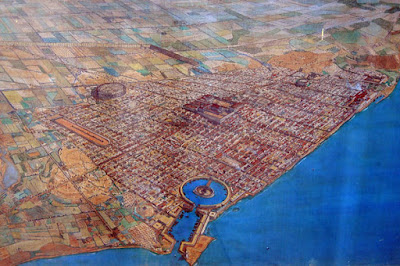Hannibal's Carthage destroyed by the Romans.
Imperial Roman Carthage
After its new foundation in 44 BC by Caesar and in a
continuous process of integration into the structures of the Roman Empire, C.
had developed economically, politically and culturally; especially under the
Severi it became one of the important metropolises of the ancient world. It was
able to maintain this status well into Late Antiquity – a development in stark
contrast to the political and economic crisis which started in the 3rd cent. in
the other western provinces. According to panegyrics of Late Antiquity
celebrating cities, C. competed for second place after Rome within the Empire
(Auson. Urb. 2 and already Hdn. 7,6,1). Together with Alexandria, Milan and
Antioch, C. was known as one of largest cities of its time (Lib. Or. 15,59;
20,40). While the epoch of the Severi was a time of assimilation into Roman
culture, the fate of the city after the 3rd cent. was marked by
Christianisation. After Rome, C. had one of the oldest and earliest organized
Christian communities of the ancient West. It quickly developed into the centre
of North African Christianity. As a late Roman metropolis, C. experienced the
conflicts with the schismatic Donatists and hosted important Church gatherings.
The activities of the Church Fathers Tertullian, Cyprian and Augustine in the
area, influenced by the metropolis C. and its rich intellectual traditions,
stimulated numerous movements which would be important for the whole of
Christianity. When the Vandals, who had invaded North Africa as early as 429,
conquered C. in 439, their goals were economic and political-strategic.
Therefore the Roman element (romanitas) remained dominant in many areas of
life. The conquerors limited themselves to the installation and the
provisioning of a ruling class and to the introduction of Arianism. Justinian’s
intervention in 533 ended the Vandals’ rule. In line with the restructuring of
the regained territory now known as Carthago Iustiniana, with C. as its
capital, there was an attempt to consolidate the new status of the city as an
administrative centre and, beginning in the 6th cent., as residence of the
exarch, through building measures and bestowal of privileges. However, the
intended renaissance of C. was hindered by military conflicts with hostile
Berber tribes and by disagreements within the army. A short phase of
regeneration was followed by economic decline and the end of romanitas. The
plans of the exarch Heraklius to make C. the capital of the Empire were doomed
to failure. The city’s demise was sealed by its conquest by the Arabs: in 698
C. was destroyed. Its successor cities were Kairouan and, especially, Tunis.
After the 7th cent. the city’s ruins were used for a long time as a marble
quarry, for Arab buildings as well as for cathedrals, for instance those in
Genoa and Pisa.


No comments:
Post a Comment